
|
|
 |

|


|
Westinghouse TX-42F450S Review
42" 1080p LCD HDTV, $699
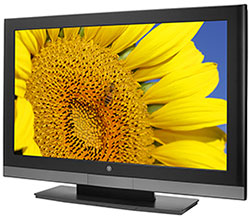
Dick De Jong Introduction
In the next few months, we will begin to experience the evolution of the TV into an Internet connected, multifaceted display device full of web content widgets. By the end of the summer, we old geezers will remember fondly the Westinghouse TX-42F450S as a throwback to the days when a TV was just a TV. Then again, this 42" 1080p LCD also serves as an indicator of how far the HDTV market has progressed in a few short years. Way back in 2007, this TV's performance would have made it a bargain at $1200. Now, it's almost half that price. Of course, to reach that under $700 mark, Westinghouse pared some of the hot new features like 120Hz playback and an Ethernet connection. But I ask you, when you eliminate extras like USB ports and Picture-in-Picture, what are you left with? A TV, plain and simple. And that is an apt description of the Westinghouse TX-42F450S. It's not the fanciest HDTV out there. It's not even Westinghouse's top of the line model. But for $699, the TX-42F450S delivers solid quality at a great price. (Editor's note: Westinghouse also makes the 47" TX-47F450S. This review can apply to it also.) Our Star Ratings
Performance: 4.0 Picture quality is average by today's standards. Contrast levels could be deeper and color rendition could be cleaner. Audio performance is adequate for everyday viewing. If you plan to listen to audio critical content like concerts, then subtract at least a half point. Better yet, use a separate sound system.
Features: 3.5 Westinghouse doesn't scrimp on HDMI inputs (four), but that's about it for features. No USB port for uploading photos, no Ethernet port for accessing the Internet, no Picture-in-Picture, the TX-42F450 is simply a TV.
Ease of Use: 4.5 With the lack of all those aforementioned features, the TX-42F450 doesn't have a lot of extras to learn, making it fairly routine to use. Though I would have preferred more responsive video setup tools.
Value: 4.5 When I start testing a new TV, I often play a game in my head of "How much is this TV worth?" At $699, in the current marketplace, this Westinghouse TX-42F450 had me nodding my head in approval. If you can find this 1080p 42" LCD for less, add a half a point.
Star Ratings Description Ratings are relative to when the review was written. The obvious example is Value, what you could purchase for $2000 two years ago or even two months ago would seem like a bad value for that price now. We have given only a precious few 5 Star ratings, which we reserve for truly outstanding accomplishment.
Out of the Box
With a wide two and a half inch flat black (not glossy) bezel, the TX-42F450S really has gone retro. Tipping the scales at almost 65 pounds when attached to its non-swivel base, this LCD is not the lightest girl in the chorus line, nor the thinnest. Most of the TV is three inches deep, except in the middle of the back where a spine juts out another couple of inches. 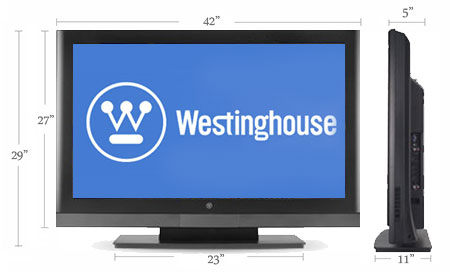 This protruding backbone contains all the audio and video connections on either side of it. When the cables are connected, they naturally droop down in what Westinghouse labels a Waterfall design. On the right side are four HDMI Ins, (one with matching stereo Audio Ins). The panel also provides a Service port and audio outputs in both analog (stereo plus a subwoofer) and digital (SPDIF optical). On the left side are the usual suspects, two Component video (YPbPr) Ins (with matching stereo Audio Ins), two Composite video Ins (with matching stereo Audio Ins), and a VGA connector (with matching stereo audio mini-jack). 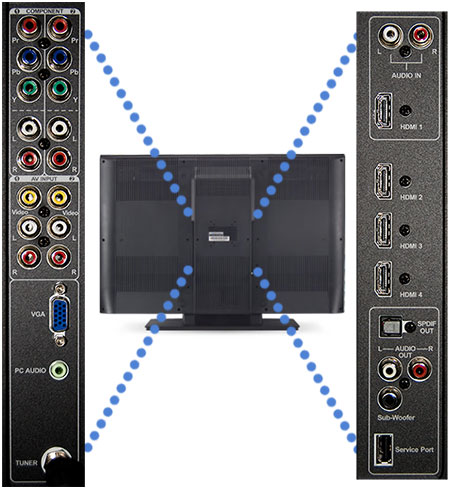 The one RF antenna connector links to integrated NTSC/ATSC/QAM tuners. Since the tuner system is Clear QAM compatible, you can attach your cable TV signal directly into the RF connector and tune in unscrambled cable stations. For those concerned about the DTV transition coming up, the ATSC tuner is the key. With the proper antenna, you will be able to tune in digital signals broadcast over the air. 
As I mentioned, the TX-42F450S does not provide a USB port for uploading JPEG photos or MP3 songs. Nor is there an Ethernet port for connecting to the Internet. Remember, this is a $700 42" TV. Even though the single function remote control supplies a PIP button, (at the top, catty corner from my favorite label "zzz"), the TV does not include Picture-in-Picture capabilities. I like the separate buttons for selecting different inputs like PC or TV, but since there are four HDMI connectors and only one HDMI button, it's more efficient to use the Input button and pick your HDMI input from the on-screen list. Power Consumption
The EPA is now publishing a list of ENERGY STAR qualified TVs. (You can find it here.) The TX-42F450S is not on the list. Therefore, we reverted back to our process of measuring the power consumption of our review units, which is straightforward. We plug the TV into a watt meter, called Watts up? Pro, and take a simple sampling of readings during the playback of a full screen video clip. The TX-42F450 provides multiple Picture Mode defaults, User, Movie, Sports, Game, and Enhanced (think Vivid). Rather, with Earth Day so near at hand, don't think Enhanced. Its decidedly non-green reading spiked to a shade less than 200W. When the mode was switched to User, which we had calibrated, the meter hovered around 130W. One of the big differences between Enhanced and User is that I turn down the Backlight. Enhanced defaults to the pupil pulsating level of 100. For User, I set it at 50. 
Interestingly, this remote control is the first one that I have seen with a Backlight button. Press it once and the Backlight lowers 10. If you believe that you absolutely require a super bright picture, do me a favor and click that Backlight button a few times and see if you can survive with a lower setting. To their credit, Westinghouse does offer an E-Saver Mode, which reduces power consumption when the TV is turned off. If you opt for the Normal mode, the TV will power up almost immediately after you turn it on. In E-saver mode, the picture will take around ten seconds to appear. Of course, Normal's instant-on feature extracts a heavy burden on your electricity bill because it draws around 30W night and day. The manual for the TX-42F450 states power consumption of the E-Saver standby mode at less than 1W. (Our readings never went above .5W.) The manual also lists Typical consumption when the TV is On at a rather liberal 250W. If we split the difference between our User rating and the manual's, the On Mode Power consumption would be 190W. For Standby Power, let's use the E-Saver number of 1W. Then we can calculate the Estimated Annual Energy Use based on the formula that the TV is on five hours a day and in Standby for the other 19. After doing the math, our unofficial Estimated Annual Energy Use would be 354 kWh/year. You need to check your electric bill to see how much you are paying for a kWh. The national average is 10.4 cents. Doing the multiplication, at that rate, the yearly energy cost to run the TX-42F450 for five hours a day would be $36.82. (Once again, this is not the official Energy Star rating.) Setup
To calibrate the TV, we use the Blu-ray version of the Digital Video Essentials DVD called HD Basics. We are playing the DVD on a Sony BDP-S350 Blu-ray player connected to the HDTV with an HDMI cable. We use the test patterns to adjust black level, white level, and color bias. The player is set to output a 1080p signal, which is the native resolution of the TX-42F450. To begin, I followed my usual pre-calibration routine. First, I choose a Picture Mode that appeals to me. Believe it or not the Game mode is even brighter than Enhanced. I would suggest that you take a long hard look at Movie. Since many manufacturers are calibrating their TVs to the Movie (or Cinema) default, it can give you a touchstone when adjusting settings. Because I like to keep it as a reference point, I chose User as the mode I would calibrate. As I said, I turned down the Backlight to 50. There is no right number and your setting may vary depending on the lighting conditions in your room. Next, I usually open up the Advanced Settings menu (Westinghouse labels it Calibration) and neutralize most of the controls until I work through the basics. For example, I turned off Dynamic Contrast and pushed the Skin Tone slider to the midpoint. I then set the Color Temperature. The TX-42F450 offers four choices, Warm, Neutral, Cool and User. If you choose User, you can fine tune individual Red, Green and Blue sliders. I picked Neutral. After that, it's time to play with the test patterns. From a midpoint of 50, I set Brightness to around 43 and Contrast to 55. 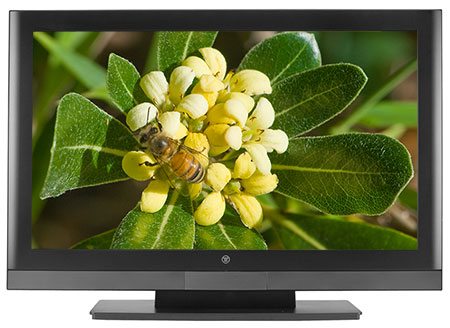 I kept buzzing around the Hue (Tint) and Saturation (Color) controls, but I was never really comfortable with my numbers. According to the test patterns, Hue should be at a reddish 54 and Saturation at a colorful 61. When I started playing regular programs, I had to turn Saturation back to at least 58 and Hue to a more neutral 50. With Sharpness, anything above 15 caused fringing. I left it at that. If you must, you can push it higher though the picture will begin to look artificial. The advanced settings in the Calibration menu are fairly spare. You can experiment with turning Dynamic Contrast On and Off. I didn't notice a big difference either way. For further fine tuning of Red, Green and Blue levels, there are individual Stretch sliders. And then, you have Skin Tone, which always seems a bit ethnocentric to me. Performance
When compared to plasma HDTVs, LCDs have historically lagged behind in Contrast performance. Though in the last few years, LCDs have narrowed the gap considerably. I believe that the TX-42F450 is still back at 2007 (give or take a product cycle) LCD contrast levels. I'm not saying that the picture quality is bad. In fact, I think it is quite presentable. Let's face it, the displays manufactured in 2009, even at the non-premium end, are not slouches. I just sampled some of my favorite Blu-ray and HD-DVD movies and the TX-42F450 does exhibit some weaknesses in image reproduction. I tried a number of adjustments to increase the depth of the blacks. Dialing up Contrast only seemed to heighten the brights and wash out the shadows. Lowering the Brightness helped a bit. Color, though often saturated, was never as crisp and defined as I would like. Simply, put this Westinghouse side by side with a higher end model and you should be able to discern differences, but so would your pocketbook. 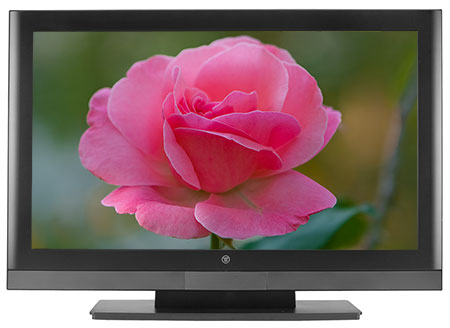 The volume output from the tiny integrated 10W speakers is surprisingly robust. Even at 25 (out of 100), the sound fills a small room. I was afraid if I pumped the volume any higher the speakers would vibrate out of the cabinet. They did not. Unfortunately, no matter what the volume, the quality of the audio was never great. It was just too live, too tinny and thin. I wanted more body, more fullness, more depth. Of course, audio quality becomes more apparent when listening to concert DVDs. For those just watching sports and Dr. Phil, you may never feel that the TX-42F450 is audio challenged. Conclusion
For the price, the Westinghouse TX-42F450 delivers solid 1080p quality in a no-frills package. If you remember that you are buying a basic HDTV, then you shouldn't be disappointed if it doesn't compare to your neighbor's top of the line model that cost twice as much. |
Bookmark:
![]() del.icio.us
del.icio.us
![]() Reddit
Reddit
![]() Google
Google
Reader Comments(1 comment)
| Send this Page | Print this Page | Report Errors |


Posted Nov 19, 2009 1:09:36 PM
By Andrew Pedersen
Anyway, as I read it, you seem to begrudgingly admit that the picture is of good quality “[The picture quality] is quite presentable. Let's face it, the displays manufactured in 2009, even at the non-premium end, are not slouches.” Your main statement to the contrary, “Color, though often saturated, was never as crisp and defined as I would like. Simply, put this Westinghouse side by side with a higher end model and you should be able to discern differences, but so would your pocketbook.” I must disagree with – when I bought it, it was playing the same blu-ray signal as roughly 50 HDTV’s all around it, some selling for as much as $4900, and I felt the picture stood up perfectly well with any other 42” model. Since getting it home and tailoring it for the lighting in my own viewing space, I find the picture as good as any I’ve seen on any 42-inch LCD HDTV.
Your largest complaint seems to be the lack of USB or RJ-45 jacks for “uploading photos” or using the Internet with the TV. Am I missing something, or are you unaware that most PC’s and notebooks sold today have HDMI output on them, so they can be connected directly to this unit to view photos, play songs, or surf the internet. There are update video cards for older PC’s available for under $40. There are also direct wireless-to-HDTV network systems for around $50 that would allow you to do all of the above wirelessly, if you so choose.
Given the differences between what I see as the first 40+ inch full 1040p 120Hz HDTV to break the $600 barrier, and the near-total lack of difference between it and similarly-sized units selling for $1000+, I have to wonder if your site is a true review site or an online commercial for higher-priced systems. Just my opinion.